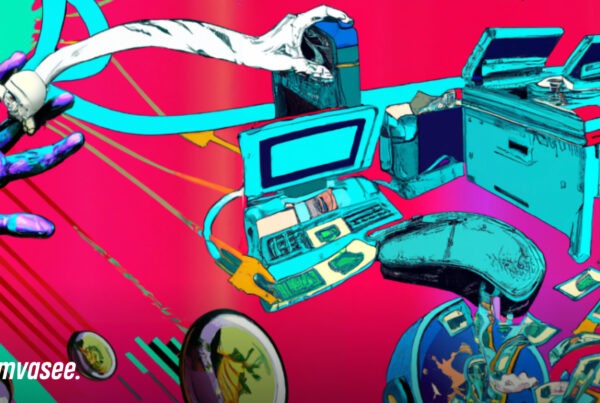
In this week’s newsletter, I’ll tell you all about American Express, which was one of the first businesses to offer credit cards. However, that is not all they do! American Express is also involved in other financial services and travel. The American Express Company is a New York-based financial corporation. It is best known for issuing and distributing credit cards, but it also processes payments and provides travel-related services to people all over the world. It is now the world’s largest credit card issuer. Every year, American Express processes 6 billion transactions. The company operates in over 160 countries, and over 63 million people worldwide have an American Express card. But how did the company become so large? Let’s take a deep dive into the company’s history, businesses, strategies, business models, money-making methods, and so on.
American Expresses is a massive credit card business. The cardholders of American Express in the U.S. spent more than 1.2 trillion dollars in 2018 on their Amex cards, up from just 45 billion in 1984. The company has agreements with at least 94 operators worldwide. They provide services such as credit, debit, and corporate cards, as well as merchant acquisition, processing, settlement, POS marketing, designing and running loyalty programmes, expense management, lifestyle, and travel services. But how did it all begin?
History of American Express
American Express Company, was founded in New York in 1850 when three major companies merged. The company Livingston Fargo and Company, The Butterfield and Wasan Company, which included the Wells and Co. company. It was one of the first and most successful express delivery companies to emerge during the United States rapid westward expansion. The United States Postal Service was slow, expensive, and in many areas nonexistent at the time. Nothing larger than a letter-sized envelope and certainly nothing valuable could be mailed, as many deliveries were lost or stolen en route.
The express companies were a lifeline for the expanding nation. Courier, parcels, freight, gold, and currency, among countless other goods, were transported by intrepid express men, who rode horses or drove stagecoaches from the eastern cities to the western frontier. American Express quickly established itself as the best in the fledgling industry – the company that literally delivered. Although American Express was not a financial services company in its early years, banks were its largest and most consistent clients. Delivering the banks’ small parcels – stock certificates, notes, currency, and other financial instruments – was far more profitable than transporting larger freight. Soon after, the company would discontinue its parcel and freight delivery operations in favour of developing and selling its own financial products.

The business was booming by the time of the American Civil War, and the company had expanded to approximately 900 offices in ten states. American Express continued to expand by acquiring other companies or striking agreements with them about which territories they would serve. They also struck deals with railroads and other modes of transportation. Because everything had to be shipped everywhere, the Civil War was beneficial to business. This is because cities were growing in size and population, and American Express was able to set up a system that allowed them to capitalise on this rapidly growing demand.
It was so successful that the Merchants Union Express Company challenged it. Both companies strived to be the best in their respective fields and fiercely competed with one another. However, both companies were on the verge of failing, so they decided to merge. This merger became official on November 25, 1868, and the new company was known as the American Merchants’ Union Express Company. It was renamed the American Express Company in 1873. The company developed a number of new services over the next few years. James Conge del Fargo took over as CEO of American Express and led the company into a period of innovation and growth. They launched the American Express Money Order in 1882, and by the turn of the century, Amex was earning $3.5 million per year from it.
American Express Money Orders
In 1882, the American Express Money Order business was one of their key innovations. People could use this service to buy certificates for specific amounts of money, which they could then use to withdraw cash or make payments. This was a convenient and secure method of money transfer that quickly gained popularity among customers.
Let me quickly give you an idea of how American Express Money Orders worked. To use the Money Order, a customer would first visit an American Express office or agent and purchase a certificate. The customer would then fill out the certificate with their own information and the information of the recipient. Once the certificate was purchased, the customer could use it to withdraw cash or make payments.
The American Express company kept growing, and in 1895, it opened its first European office in Paris. Soon after, offices opened in England and Germany, and the company’s services were available in places like China, Japan, Brazil, Argentina, India, and Egypt.
The Expansion of Money Orders Worldwide.
Another aspect of the money order business that the company only discovered later was that immigrants frequently used money orders to send money back to their home countries. This was especially common in the early 1900s, when many immigrated to America for better opportunities and a higher standard of living.
Money orders were frequently used by these immigrants to send money back to their families and friends, and American Express quickly became one of the leading providers of these services. American Express was able to tap into a growing market and generate additional revenue from its operations by offering money orders. In addition to providing a valuable service to immigrants, the money order business had a positive impact on American Express’s reputation and brand.
American Express was able to position itself as a global company committed to helping people all over the world by facilitating the transfer of money between different countries.
The origin of Amex Travellers’ cheque
American Express found itself developing relationships with financial institutions abroad to expand globally and influence nearly every aspect of the business. This relationship-building contributed to American Express’s rapid growth. Even when a European bank honoured the letter of credit, obtaining cash in smaller towns was generally difficult due to long wait times and wildly fluctuating exchange rates. When JC Fargo, the CEO of American Express at the time, travelled to Europe, he felt belittled by the fact that he had to wait for funds as the CEO of a major financial institution. This prompted him to advocate for the creation of traveller’s checks. With the introduction of the travellers’ check in 1890, Amex made its second important breakthrough, which would become a huge source of revenue for the company for the next 100 years. People started using traveller’s checks instead of letters of credit, which were usually accepted by banks in major European cities but not always in smaller ones. For many years, American Express Traveller’s Cheques have been a popular option for travellers looking to protect their funds while abroad. But what are they exactly, and how do they work?
Traveller’s Cheques from American Express are prepaid currencies that can be used instead of cash when travelling. Depending on how much a traveller spends on individual purchases, they are available in denominations of $20, $50, $100, $500, and $1,000. Amex gradually increased security layers, such as the initial double-signature system, payment guarantees, and insane dependability. Unlike carrying large amounts of cash, if your Traveller’s Cheques are lost or stolen, you can easily replace them, so travellers naturally preferred these traveller’s cheques over cash. The company convinced European banks, hotels, and other businesses to accept travellers’ checks, increasing the product’s acceptance in their eyes. Because of the high demand, accepting travellers’ checks made sense for these businesses, and it brought them more customers.
These travellers’ checks are a representation of money. To understand the concept of something becoming a representation of money, read my article “What do you mean money doesn’t exist?” To read it, go here.
American Express invented the traveller’s check, which went on to become a huge success. Travel by Americans to foreign countries was a growing trend. The traveller’s check, like the money order, earned the company money through the float, but because there was no expiration date and many people simply never cashed checks they had already paid, the float was much larger and more stable than the money order.
Floating the money.
Amex invented the “float” after noticing that funds from uncashed money orders had been sitting on its books for some time.
What exactly is float? The amount of money held by the company before it is transferred to the appropriate recipient is referred to as float. This can happen in a variety of situations, such as when a customer uses their credit card to make a purchase, when a merchant processes a transaction, or when a financial institution processes a payment.
Float is a critical component of American Express’s business model because it enables the company to generate additional revenue by investing in additional interest-bearing assets. By temporarily holding funds, American Express can earn interest on the money it holds, which can help offset the costs of providing its services. Furthermore, float can assist the company in managing its cash flow and liquidity, both of which are critical for maintaining a healthy financial position. As money order sales increased, so did the amount of money in American Express’s float, making American Express a lot of money in the process.
The war
When World War I engulfed Europe in the summer of 1914, approximately 150,000 American tourists were stranded, many without access to funds. Banks had stopped paying against foreign letters of credit. Panicked travellers waited inside and outside American Express offices in whatever city they happened to be visiting. American Express was able to fully cash all travellers’ cheques and money orders, allowing thousands of people to return home quickly. Many of those who remained were able to book flights home soon after American Express and a group of nine US banks decided to ship $10 million in gold to Europe so that local banks could once again honour foreign letters of credit.
American Express also provided other services throughout the war. The company was appointed as the British government’s official agent to deliver relief parcels, letters, and money to British prisoners of war in Germany. American Express eventually delivered 150 tonnes of packages per day to British detainees in Bulgaria, Germany, Holland, Norway, Switzerland, and Turkey. Employees also went into prisoner-of-warcamps to cash letters of credit and make arrangements for British and French prisoners to receive money from home.
The travel industry.
It had also entered and exited the banking industry, been involved in a number of foreign exchange businesses, and evolved into a one-stop travel agency during this time. American Express first entered the travel industry in 1915. Within a decade, American Express was organizing tours to Europe, South America, the Far East, the West Indies, and other parts of the world. After successfully chartering the first around-the-world cruise, a four-month, 30,000-mile voyage of the Cunard liner, Laconia, with stops in Cuba, Panama, Honolulu, Japan, China, Java, Singapore, India, Cairo, and the Mediterranean in 1922, the company became synonymous with luxury travel. The Laconia continued to transport passengers all over the world for another 20 years before being torpedoed and sunk during WWII. But in the 1950s, everything changed.
The arrival of credit cards.

Credit cards were thought to be a promising new industry at the time, but there were no large-scale, widely accepted cards. The Diners’ Club card changed the game in 1950. It was accepted by a number of entertainment providers and demonstrated the viability of such a product. American Express first entered the market in 1958. They negotiated the acquisition of the American Hotel Association’s branded card in order to gain access to well-established hotels and restaurants that would accept the new card, as well as 150,000 cardholders. They also purchased a list of customers from the Gourmet Card’s owners, which added an additional 40,000 people to the rolls and by the time Amex launched, they had 250,000 customers ready to go. It was so popular that 500,000 people had one within the first three months, and I believe this was the primary reason their income increased tenfold during the 1960s.
American Express’ credit card business was not a success from the start. There were too many delinquent accounts, insufficient credit worthiness checks, insufficient membership fees, and customers who needed to be educated on the importance of paying every month rather than waiting 90 days or longer. They hired a man named George Waters, who turned out to be exactly who was needed to right the ship despite having no experience in the credit industry. Waters overhauled everything, from accounting to credit checks, to purging the membership list of all customers who had taken advantage of Amex’s disarray the previous year. He was extremely successful at this, and by 1967, there were 2 million cardholders spending over $1 billion per year and profiting six figures.
Then, their famous green cards and corporate cards catapulted them to the next level, and American Express became one of the world’s most respected and valuable corporations. The credit card business aided them so much that they were able to acquire all of these other financial businesses over the next few decades. They’ve since sold most of them, but they did own an insurance company and a brokerage firm at one point.
Today, they are a global payments company that is primarily focused on platinum and other premium cards, and I want to look at their platinum card because I believe it is an excellent example of how they conduct business. The platinum card has no interest rate because the full balance must be paid off at the end of each month. Unlike other credit cards from banks that operate on ‘lend-centric‘ business models, American Express, actually wants you to pay your bill on time.
The latter half of the twentieth century.
Throughout the 1960s and 1980s, they appeared to be unsure of their identity and were constantly pursuing new business opportunities, whether or not they fit well with their structure. Furthermore, instead of focusing on what they did best, American Express attempted to establish a conglomerate by purchasing several companies to form a conglomerate business. They also dabbled in investment banking and stock brokerage. Attempting to acquire McGraw-Hill Publishing, which was a major source of embarrassment for management, making overtures to Disney Warner Communications, and an unfortunate merger with the privately banked Safra Mund.
American Express executives have long argued that there should be additional sources of income in addition to the card, traveller’s checks, and insurance. Not only would a new venture improve Amex’s bottom line, but it would also safeguard the company by diversifying its earnings outlook. However, much time has been devoted between the 1980s and the present to dissolving businesses, such as the investment banking segment, and becoming a leaner, more focused organisation. Cutting out unnecessary business and becoming a leaner organisation was exactly what was required to position them for success.
Here comes the money-making part.
The most well-known credit card is American Express. Everyone has a Visa or Mastercard, but few have an American Express card. According to fool.com, there were over 3.4 billion Visa cards, 2.5 billion Mastercards, and only 63 million American Express cards. This is because American Express is less concerned with volume. Visa and Mastercard are issued by banks, but American Express handles the majority of the issuing and processing themselves.
The most notable distinction is that they offer more than just a credit card. It’s possible that comparing the number of Visa and MasterCard cards issued to American Express isn’t even fair. They are more concerned with how much money they can make from each card than with the number of cards they issue. This is a more significant figure because, despite having fewer cards, American Express earns significantly more per card. They care more about how much money they can make from each card than how many cards they issue. This is due to the fact that, despite having fewer cards, American Express earns more revenue than Visa or Mastercard. It’s actually higher than the sum of Visa and MasterCard, indicating that, despite their lack of popularity, they have their own system called “spend-centric” in place.
What is Spend-centric?
American Express’ business model, dubbed “spend-centric,” is centred on attracting premium card members who spend more per card, allowing Amex to charge premium prices to merchants, which Amex then invests in card member rewards and services. This model contrasts with the majority of the competition’s other “lend-centric” issuers, which rely heavily on increasing card member loan balances and maximising interest income. Rather than interest income, American Express derives the majority of its revenues and profits from recurring fees.
The revenue in card fee.
Any business that accepts credit cards as payment must pay a commission to the card issuer, such as Visa, Mastercard, our very own RuPay by the NPCI, or American Express. As an example, consider Flipkart. When you use your Visa card to make a purchase on Flipkart, it is usually less expensive for Flipkart, than when you use your American Express card. American Express incentivises you to use their card because, compared to Visa or MasterCard, they can make a relatively high percentage of fees on each transaction. As a result, the more you use your credit card, the more money American Express makes. This is where the majority of their money comes from, hence the term “spend-centric.”
Why would these vendors accept American Express at all?
You might be wondering. If it is so expensive for merchants, why would they even accept it? Most people do not have an American Express card, so why bother if it will be more expensive to accept AMEX? Because of its prestige, it is said to be accepted by nearly as many merchants in the United States as Visa or Mastercard. In India, acceptance is still low, but it is improving. You can use it in almost all major e-commerce websites and payment gateways online.
What does American Express’s future hold?
Everyone is an American Express competitor, even Apple, which recently issued a credit card in partnership with Goldman Sachs. Because banks can’t afford to quit a booming market where they’re building up receivables, there will always be a lot of competitors in the business. The credit card industry operates similarly to the automobile industry. There are numerous automobile manufacturers. Ferrari will make a lot of money, but its market share will be minimal. Toyota will produce much more vehicles than Ferrari, but they will make less money per car.
The brand has built a reputation for prestige and exclusivity, which has attracted a high-earning clientele. In order to maintain the loyalty of its existing members and attract new clients, the company must continue to offer high-quality products and services that are in line with the brand’s luxury image. This could include offering exclusive perks and benefits, such as access to VIP events or concierge services, as well as highlighting the financial advantages of using the brand’s card over rival issuers. Additionally, the company could focus on providing exceptional customer service and support to further enhance the brand’s reputation and appeal. By offering compelling reasons for both existing and potential clients to remain loyal to the brand, the company can continue to thrive in a competitive marketplace.
However, the future of the credit card industry is uncertain, and it remains to be seen how American Express will adapt to changing market conditions. The company will need to continue to innovate and evolve in order to stay ahead of the competition and maintain its position as a leader in the field.
To that end, I offer my sincere thanks for reading this week’s newsletter about the American Express Company. Leave a comment with your thoughts or suggestions for future article topics, and I’ll be sure to take them into consideration.



